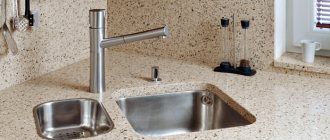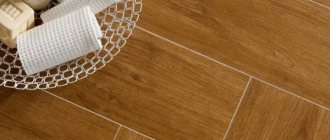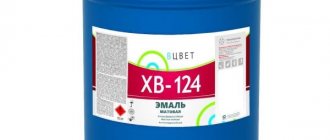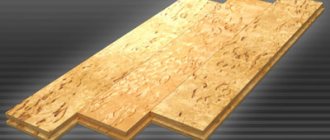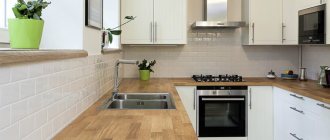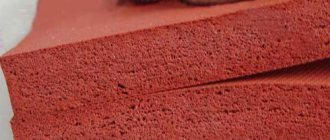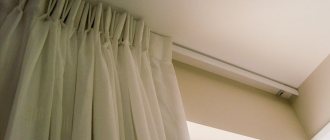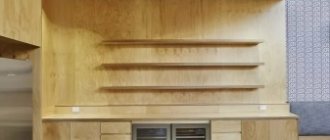Porcelain tile is one of the most successful types of artificial stones; it is made from special components by firing at temperatures up to +1300°C. As a result, the ingredients melt and form a single, very strong structure that has high performance characteristics. At first it was used only for industrial and technical premises, but modern technologies have made it possible to significantly expand the design characteristics; the front surface can resemble natural materials, have different structures and colors, wide roughness values, thickness and linear dimensions.
Porcelain tiles
When choosing a specific brand of flooring material, you need to pay attention to all the characteristics of porcelain stoneware slabs, including their thickness. The larger it is, the higher the resistance to bending loads, including impact loads. But not everything is so simple; this dependence is not direct, but has several factors. The standard thickness of the slabs ranges from 7–12 mm, but for some types of floors thinner or thicker porcelain tiles can be used. The cost of materials also depends on the thickness; this is due to the fact that their production requires an increased amount of raw materials, the firing process is delayed, and this causes excessive energy consumption. What should be the thickness of porcelain stoneware, what are the features of its installation depending on this indicator?
Porcelain stoneware floor
Properties of porcelain stoneware
To this day, ceramic tiles have not lost their popularity. It is used for external and internal work. A wide range of colors, delightful tile patterns designed for different rooms, a wonderful practical, durable decoration for different interiors.
Its manufacturing technologies have improved. Wall tiles are made from a mixture of clay, sand, and additional materials, which is fired in molds. Enamel is applied to the resulting plates and fired again.
A more complex process is making durable tile floors.
- To achieve high density and reduce the porosity of the material, a powerful press is used at the initial stage.
- The pressed slabs are covered with enamel and fired once at a higher temperature.
- A hardy floor tile is created.
Tile is very suitable for apartments, private houses, and offices. It does not require significant costs; serves for a long time without changing its appearance at all; beautiful, colorful; environmentally friendly, safe; resistant to temperature changes and moisture.
Grouting joints
There are separate putties for sealing tile joints. Standard adhesive cannot be used for installation - it has a coarse-grained structure and an unaesthetic appearance.
If there are expansion joints, they must be sealed with silicone or two components:
- Elastic filler. Suitable materials include polystyrene foam and polyurethane foam. The depth of the seam should be greater than the size of the strip - this will allow space for the expansion of the filler.
- Surface sealant. There are products based on silicone and polyurethane. Such sealants are characterized by increased elasticity, so they can be used for grouting gaps.
Cement putties
Cement grouts are inexpensive and come in a variety of colors, which makes them popular and widespread. Optimal material from European manufacturers. The choice of fugue must be taken responsibly, because even if the cladding is done at a professional level, poor-quality putty will completely ruin it after a while.
Typically, porcelain stoneware is laid in places of high humidity, so you should buy putty with antifungal and moisture-repellent elements in its composition. To ensure enhanced waterproofing of joints, there are special drinks that are used to cover caulked joints. There are 2 classes of impregnations, differing in the degree of penetration into the fugue:
- Polymer varnish. It is characterized by high waterproofing and deep penetration.
- Water repellent. Used to impregnate the putty surface. If the top layer of the fugue is damaged, water barrier weak points will arise.
Before applying impregnation with a brush, you should protect the tile from contact with the composition, otherwise stains will appear on its surface. Double application is necessary: repeated treatment is carried out every other day.
No earlier than 24 hours after lining, you can begin to cover the seams. But if quick-setting glue was used, then the waiting time is reduced to 3-4 hours from the moment of installation. It is necessary to thoroughly clean the joints from the binder mixture and wash the tiles. When mixing grout, follow the manufacturer's instructions.
Joining requires a rubber spatula or grater - with the help of these tools a fugue is applied to the seams. To prevent the caulk from breaking down, fill at least 2/3 of the depth of the gap with the mixture. The composition should be applied with effort. Voids require re-processing. Residues are immediately removed with a spatula. One approach allows you to process up to 3 m2. The chosen manufacturer and type of putty influence the specific area.
The easiest way to proceed is with glossy porcelain tiles. In the case of structured or matte material, grouting becomes more complicated: due to the penetration of the fugue into the pores, it is difficult to wash out. In such situations, you should wash the mixture using a dampened dish sponge, applying its hard part to the surface.
The final step is to treat the seams with a moistened foam sponge. A number of manufacturers offer special products, but their use is not necessary. The main thing is to move diagonally in relation to the joints, since if you move parallel, the fugue from the gaps will be washed out.
It is first necessary to smooth and compact the fugue layer using a round rubber spatula or a cylindrical cable (8-10 mm). This will ensure that the seams are evenly deepened and smooth. After 10-20 minutes, when the grout begins to dry, you can completely wash the lining.
Epoxy putties
Epoxy putties contain resin and filler. If you grout the seams with such a fugue, this will ensure their higher quality compared to cement putty. The material is characterized by increased density, resistance to moisture and chemicals.
Applying epoxy putty is a more complex procedure compared to standard grout. When mixing the components, carefully observe the gramming and wear rubber gloves to avoid harm to your health. In one approach, a maximum of 1 square of cladding should be processed. The spatula movements are standard. The finished composition “lives” for a maximum of 30 minutes.
Undried seams should be thoroughly wetted with water using a kitchen sponge until an emulsion is formed. Be careful not to allow the mixture to wash out of the joints.
To remove liquid residues of the mixture, a rigid cellulose sponge is used. Once the sponge is soaked in resin, it changes. The manufacturer Litokol offers sponges designed specifically for working with epoxy grout. Their cost is higher, but their service life is longer. It is important to wash off the epoxy before it begins to harden. If plaque remains, use a solution of water and specialized detergents (or 10% ethyl alcohol).
A little about silicone
Silicone gets on the ceramics, so it must be urgently removed with ethyl acetate, toluene or gasoline before it sets. If the material has time to harden, then the solvents will be powerless - you will have to resort to mechanical force, which increases the risk of damaging the tiles.
Porcelain tiles or artificial stone - which is better?
Ceramic tiles are the predecessor of a new modern finishing material with increased strength - porcelain stoneware. It is considered a good substitute for natural stone and is also called artificial stone.
The qualities justify this name. Porcelain tiles can imitate the surfaces of not only stone, but also wood and leather. It looks very natural, creating a noble atmosphere of natural freedom, simplicity, cleanliness, order.
Slicing at home
Regardless of the size you choose, you will need to trim the porcelain tiles to fit along a narrow row of walls. Those who decide to do diagonal styling will have a lot of this work especially.
While ordinary ceramic tiles can be cut quite easily even with an ordinary glass cutter, porcelain tiles are practically impossible to cut with such a tool.
Cutting porcelain tiles at home
Advice! To avoid a situation where you cut off a narrow strip of a few centimeters for the last row, you should calculate the width of all tiles in advance, taking into account the gaps. If you see that there is a narrow gap left, it is best to correct this by cutting to the width of the first row. Then you will get the first and last row of half a tile, which is much better than a 1-2 cm strip.
Durability of porcelain stoneware
Porcelain stoneware is produced from sand, clay, feldspar (crystals of this natural mineral in the form of bars were often found in the fields), mica, and granite chips, necessary for high strength.
- The mixture, to which the listed materials are added in a certain proportion, is pressed at high pressure (400 - 500 kg/cm2).
- This is necessary for increased strength. Then they are fired at temperatures up to 1300 degrees. This creates slabs that do not contain pores.
- They do not crumble or break from gravity or impacts from hard objects. They do not absorb moisture at all, are frost-resistant, and do not allow cold or heat to pass through.
- They are not afraid of fire. Service life - up to one hundred years. Plates, especially matte ones, do not change their appearance throughout their entire service life.
- They are not afraid of ultraviolet radiation. They can be cleaned with any chemical means without fear that the surface will deteriorate.
There are no chips or cracks on it. High density and absence of pores prevent the absorption of dirt, grease, and paint, which are easy to clean.
General characteristics of the material
Porcelain stoneware is a facing material for decorative finishing of internal structures, the façade of a building and pedestrian areas. Tiles are often compared to natural stone, conventionally calling it an artificial analogue (ceramic granite). This is due primarily to the mineral composition and similar technical characteristics. This is especially evident in the strength, density and resistance to various climatic conditions, regardless of the size of porcelain stoneware.
Production Features
The basic component of the raw material for the production of porcelain stoneware is slip. This is the so-called porcelain mixture. It contains the following ingredients:
- kaolin or white clay – gives the material heat resistance, belongs to the group of binders;
- illite clay – is responsible for the plasticity of the working mass, helps to increase the bending strength of the finished product;
- quartz sand – due to its hardness, it provides high mechanical endurance to the tile;
- feldspar - in addition to strength characteristics, due to the component of the product, they are inert to chemical reagents;
- water - used as a basis for preparing a homogeneous mass.
Kaolin clay Source goodsam.ru
The finished substance is brought to a powdery state and fed to special pressing equipment. Here, the raw materials are exposed to heat within +1200 degrees Celsius, pressure in the range from 400 to 500 kg/sq.cm. This is how the components sinter together, eliminating moisture and air from the mixture. At the final stage, porcelain tiles of any thickness are sanded, polished, glazed or decorated with a pattern - the activities are determined by the choice of a particular collection.
Color is provided in various ways. These can be mineral pigments, oxides, which retain or change the original color during the sintering process. If the second option is used, then different parts may differ slightly in key. Porcelain tiles can also be painted throughout the entire mass or partially (only on the front side).
Samples of porcelain tiles with solid and surface coloring Source alicdn.com
Varieties
There is an opinion that ceramic tiles are a type of porcelain stoneware of one thickness or another for floors or walls. This can only be justified by the similar composition and manufacturing principle of the materials. However, the first samples are subjected to noticeably less impact from the temperature and mechanical pressure of the press. Therefore, lower strength, density and wear resistance are observed here.
Porcelain stoneware itself is classified according to its design, which is manifested in appearance. In particular, the following tile options are distinguished:
- Homogeneous. Such samples are otherwise called de facto standards. Here, coloring of the workpieces is carried out throughout the entire volume.
- Partially painted. The process is carried out in two stages: primary pressing of the base mass, secondary - with the addition of a pigmenting component to the surface layer. This approach makes it possible to reduce the cost of production, and therefore reduce the cost of finished products.
- Glazed. Here, colored glaze is used as an alternative to surface coloring.
An example of a glazed coating for tiles Source skladkeramiki.ru
- Matte. This coating option is obtained naturally in pressing equipment. It is believed that these samples have a better ability to cope with operating conditions.
- Smooth. Here the front side of the tile is polished using diamond abrasives of various fractions. The disadvantage of this approach is the formation of micropores and microcracks, which reduce the strength of the cladding. Therefore, samples are recommended for work inside the building.
- Polished (glossy). The effect is created due to a special composition that is applied to the surface of the workpieces at the firing stage.
- Structured. Here, a relief pattern and anti-slip strips are formed on the surface (for example, for facing steps).
The so-called technical porcelain stoneware for laying on floors with standard or increased thickness stands out separately. These are products with a basic composition and a matte surface without any processing after pressing and firing. Due to its high strength and low cost, I often use it to decorate utility rooms, pedestrian areas outside, and bath floors inside steam rooms and showers.
An example of a porcelain stoneware floor in a bathhouse Source twimg.com
See also: Catalog of companies that specialize in finishing materials and related work
Main qualities of porcelain stoneware
Currently, porcelain stoneware slabs are produced in different sizes, thickness, weight, and color. These qualities are important for proper installation and use of durable and beautiful material.
At first, it was used to make floor coverings that could withstand heavy loads in industrial premises. Now it is used to decorate home, office, garage floors, terraces, verandas, external and internal walls, and spaces around fireplaces. Durable porcelain stoneware furniture fits stylishly into the interior.
- The initial difficulty in purchasing slabs is color. It is impossible to choose absolutely identical shades.
- Buyers who are interested in the same color, pattern, or symmetrical design are better off choosing tiles.
- Each batch of clay, feldspar, and marble chips - the components of the porcelain stoneware mixture - can have its own shades, which is why the final product - the slabs - turns out to be of different colors.
- Manufacturers make sets of slabs from the same batch that are most similar in color. Other sizes are standard.
In most cases, porcelain stoneware is purchased for flooring. It is important to carefully consider the feasibility of installing it where it will be moistened - in the bathroom, swimming pool.
The monolithic structure does not absorb moisture and becomes slippery, so in such cases it is safer and cheaper to install high-quality tiles.
Ceramic granite 600x600 mm: use
You can choose blue, black (absolutely any) ceramic granite for finishing work on interior partitions in companies that are based in Moscow
The functionality of the tiles is mainly determined by the shapes. The dimensions of the coating are important, and ceramic granite 60*60cm is very popular, since its dimensions allow you to cover different areas.
Tile
600x600 mm is found in the following options:
- facade cladding of the house;
- finishing staircases, covering floors that are subject to heavy loads;
- cladding of interior partitions.
Square-shaped porcelain tiles with a side of 60 centimeters are used for various purposes in construction. The color palette of tiles is varied. This size greatly increases productivity, and the surface covered with these tiles will seem complete. This finish will look especially great on large façade surfaces or in public rooms.
Ceramic granite 600x600 is very difficult to cut, so, in order not to complicate the installation process, buy very small tiles, which are used simultaneously with ceramic granite for a 60 by 60 cm floor.
To ensure a seamless surface during the laying process, cuts are made along the edges of the tiles with a diamond blade. This process is called rectification.
Main types of porcelain stoneware
Floor slabs come in the following types:
- Technical (for industrial premises);
- Matte. Porcelain tiles are stable, do not change color, and are non-slip;
- Polished: mirror surface, high wear and abrasion;
- Satin: with a slight shine from mineral salts and baking. Wear-resistant;
- Structured with a relief surface of stone, wood, leather;
- Glazed: stronger than tiles, but subject to wear;
- Lapped – partially polished and matte. Such slabs are also called semi-polished;
- Double backfill slabs: 3 mm of the top layer - colored components, and then - the main ones. Rainbow tiles with good wear resistance;
- Rectified - cut with special waterjet cutting tools for uniform size, absence of error and perfect alignment when laying. The magnitude of the possible size discrepancy - caliber - should not exceed 5 mm.
Ultra-thin porcelain tiles
This type of product belongs to a special type of finishing materials, the thickness of which is no more than 4 mm. Many consumers, as well as manufacturers, note a number of undeniable advantages of products in this category:
- Low own weight of products - products with dimensions of 400x400 mm or 500x500 mm weigh no more than 2 kg.
Ultra-thin material
- Reasonable retail price due to the small amount of raw materials used.
- The tiles are ideal for wall cladding in rooms with high humidity.
- When covering walls in rooms with a small area, for example, when performing finishing work in separate bathrooms, the product “eats up” minimal space.
Wall covering
- Can be mounted on thin partitions with low load-bearing capacity.
At the same time, this porcelain tile has a number of disadvantages, which is why not every owner of an apartment or private house gives it preference:
- Increased fragility of the structure - the material breaks even with minor impacts.
- Difficulty during installation - installing products on the wall requires the involvement of highly qualified labor.
- Increased requirements for careful operation, in the case of installation as a floor covering.
Crack on porcelain stoneware
Thus, this finishing element should be installed exclusively on walls, subject to the involvement of a proven installation team.
Features of laying ultra-thin porcelain tiles
When laying ultra-thin porcelain tiles, the master must take into account the following nuances:
- Taking into account the increased fragility, it is prohibited to apply strong pressure when fixing the element with adhesives.
Tile adhesive
- Installation is carried out only on plastic adhesive materials that do not contain solid inclusions of coarse sand.
- When laying, you need to use a spatula with a large tooth.
- The glue must be applied to a pre-leveled surface.
- The thickness of the adhesive composition should not exceed the thickness of the tile.
Applying glue with a notched trowel
- Considering the fast setting period of the tile adhesive, all work should be carried out with increased intensity and in the shortest possible time, which requires additional qualifications from the master.
- In some cases, experts recommend laying ultra-thin porcelain tiles over old tile material.
- When cutting material, the use of manual tile cutters and other tools whose operation involves exerting increased pressure on the element is not allowed.
Cutting with a diamond blade
- During installation, special attention should be paid to the absence of voids in the adhesive composition, since the presence of these defects can cause destruction of the material during careless use, which is especially important for flooring.
- Regardless of the area of the surface to be finished, professionals recommend carrying out installation work without interruption, which reduces the risk of cracking of the material due to shrinkage of the adhesive composition.
Construction of an extended wall
Thus, given the large number of complexities, ultra-thin porcelain tiles enjoy minimal popularity among consumers. While saving on material, the owner of the premises has to overpay for the work, and the end result is worse than when installing standard porcelain stoneware.
Porcelain tile thickness: how to choose
The smallest thickness is 3 mm, the largest is 30 mm. The thicker the material, the stronger and more expensive it is. This does not mean that thin porcelain tiles are not of high quality. When installed correctly, the functionality of different types of porcelain tiles is the same.
For example, in the kitchen and rooms it is necessary to install thinner slabs, which are cheaper. Those that need to be used to lay out the floor in the garage will not fit here.
- The most optimal thickness for floor coverings is 8.5 mm. Possible load - 200 kg/cm2.
- The thickness of porcelain tiles from 11 mm is already considered large.
- They can reach 3000 mm in width and length.
- Their thickness is up to 5 mm, since with a larger thickness it will be difficult to work with them due to their weight.
Thick tiles with smaller dimensions are the most durable. They are used for industrial premises with significant weight loads.
Briefly about the main thing
Porcelain tiles or artificial stone are made from mineral components under high pressure by firing.
The material has high strength and hardness, but is characterized by fragility.
According to the standard for floor finishing, the thickness of the tiles must exceed 7 mm; there are wall samples with a minimum height of 3 mm.
It is necessary to choose porcelain stoneware taking into account the load on the vertical or horizontal base.
For walls, ceilings and facades, samples with a thickness of 3 to 7 mm are considered.
For the floor inside the building, depending on the load placed on it, porcelain stoneware with a thickness of 7-9 to 16 mm is selected.
For finishing the porch and landscaping the courtyard area, collections with a height of 16-20 mm are better suited; for transport loads, you need to lay tiles 30 mm thick.
Ratings 0
What to look for when buying porcelain tiles
When purchasing porcelain tiles, you need to check whether the tiles match the color. Weight also matters.
- The most suitable tiles for flooring are 8 - 8.5 mm and weigh approximately 18.5 kg. Low-quality fakes may be easier.
- The reverse side of the tile should be covered with small ribbed squares.
- The thicker they are, the better the quality of the product. A rough surface with squares is needed for a strong connection with the glue and the floor surface.
On the packaging of high-quality wear-resistant material, a foot is drawn on a black background. With increased density and frost resistance, a snowflake is drawn.
Convenient and practical porcelain tiles
Porcelain tiles install well even on uneven surfaces with differences of up to 15 cm. This should not be abused. It is better to level it with concrete and make a screed. Do not lay the material on a wooden floor.
With proper installation, use and care, porcelain tiles will delight you with their appearance and practicality for decades.
Alignment methods
When working with porcelain stoneware, use a holder with suction cups. As a result, you will be able to lift heavy tiles when they are piled up.
Often the tiles clearly float on the adhesive, pressing it down, especially if there are differences in plane on the floor. Uneven shrinkage occurs. If the glue is made thicker, it will begin to lag behind the porcelain tiles, so you should use other methods.
When laying heavy porcelain tiles with joints, tile leveling systems should be used. Few piece systems are needed, since the products are usually large in size. Thanks to the SVP, you will ensure an absolutely flat floor surface.
Seamless installation requires a different method. Under the corners of the tiles, 4 screws in plastic plugs should be driven into the floor. Adjust their height by scrolling before applying the adhesive, aligning the tiles in the plane of the floor. This will allow you to lay heavy porcelain tiles evenly, although it will require considerable effort.
Porcelain tiles do not have edging or distorted geometry, so precautions must be taken. An insufficiently responsible approach to work will lead to the fact that even small flaws will completely ruin the floor covering.
